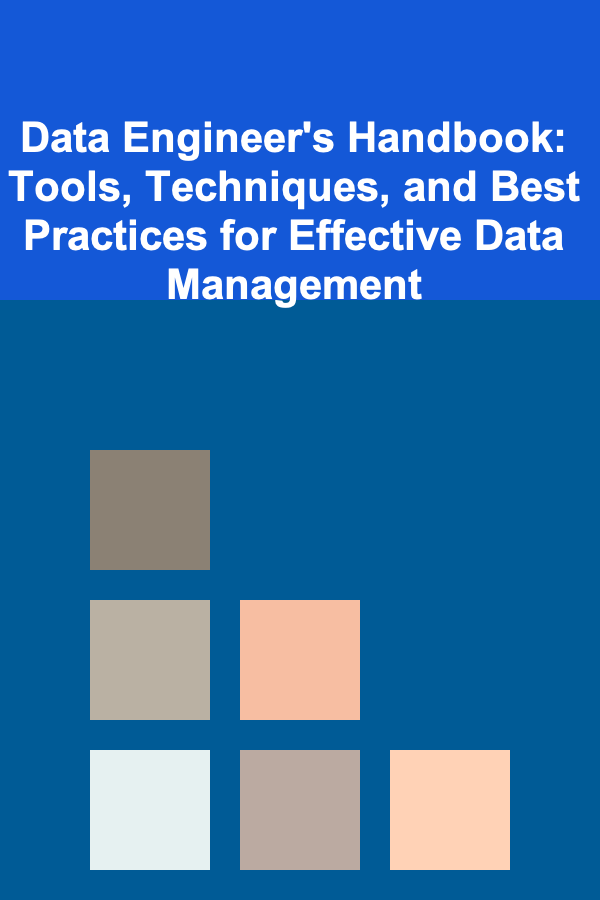
Data Engineer's Handbook: Tools, Techniques, and Best Practices for Effective Data Management
ebook include PDF & Audio bundle (Micro Guide)
$12.99$8.99
Limited Time Offer! Order within the next:

Data engineering is the backbone of modern data-driven organizations. As data becomes an increasingly valuable asset, organizations rely on data engineers to design, build, and manage the infrastructure and systems that enable efficient data collection, processing, and analysis. Whether it's integrating disparate data sources, building data pipelines, or ensuring data quality, a data engineer's role is critical to enabling the flow of actionable insights across an organization. This handbook aims to provide an in-depth look at the essential tools, techniques, and best practices for effective data management in the context of data engineering.
Understanding Data Engineering
Data engineering involves the design, construction, and maintenance of systems and infrastructure that handle large amounts of data. It focuses on optimizing the collection, storage, and processing of data so that it can be used effectively by other parts of the organization, including data scientists and analysts.
Core Responsibilities of a Data Engineer:
- Data Integration: Combining data from multiple sources into a unified format or location.
- Data Pipeline Development: Designing, developing, and maintaining data pipelines for processing and transforming raw data into usable formats.
- Data Warehousing: Building and managing data warehouses or lakes where large datasets are stored and accessed.
- Data Quality Management: Ensuring that the data is accurate, complete, and consistent.
- Performance Optimization: Tuning systems to handle large-scale datasets and high throughput.
- Automation and Scalability: Ensuring data workflows can scale as data volumes grow and automating manual tasks.
Data engineers work closely with data scientists, software engineers, and business intelligence professionals, ensuring that data infrastructure is optimized for analysis, reporting, and decision-making.
Essential Tools for Data Engineering
The tools a data engineer uses are crucial to their effectiveness. A wide variety of platforms and software exist to handle specific aspects of data engineering. Here are some of the core tools that data engineers rely on:
a) Data Storage and Databases
A data engineer needs to select the right storage and database solutions that can handle the scale and complexity of an organization's data needs. These can range from traditional relational databases to NoSQL systems and large-scale data lakes.
- Relational Databases (RDBMS): These are suitable for structured data and support ACID transactions. Examples include PostgreSQL , MySQL , and SQL Server.
- NoSQL Databases: NoSQL databases like MongoDB , Cassandra , and Couchbase are designed to store semi-structured or unstructured data, making them ideal for applications with large-scale data and high availability needs.
- Data Lakes: Tools like Amazon S3 , Google Cloud Storage , and Azure Blob Storage are used to store raw, unstructured data. Data lakes are scalable and cost-effective solutions for large volumes of data.
- Data Warehouses: Data warehouses like Google BigQuery , Amazon Redshift , and Snowflake are optimized for fast querying and reporting, particularly with large datasets.
b) ETL/ELT Tools
ETL (Extract, Transform, Load) and ELT (Extract, Load, Transform) tools are used to extract data from source systems, transform it into the required format, and load it into the data warehouse or lake. These tools help automate the data pipeline processes and ensure that data is moved and transformed with minimal manual intervention.
- Apache NiFi: A robust open-source tool for automating data flow between systems.
- Apache Airflow: A highly extensible tool used for orchestrating complex data workflows, including ETL tasks.
- Talend: A data integration and transformation tool with a focus on user-friendly data pipelines and enterprise-level scalability.
- dbt (Data Build Tool): A command-line tool that enables analysts and engineers to build data transformation pipelines in SQL.
c) Data Processing Frameworks
Data processing frameworks allow data engineers to handle large-scale data transformations and computations. These frameworks provide the necessary infrastructure to process data in parallel across distributed environments, which is crucial for handling big data workloads.
- Apache Spark: A unified analytics engine for big data processing, Spark can handle both batch and real-time streaming data. It is one of the most widely used tools for distributed data processing.
- Apache Flink: Similar to Apache Spark, Flink specializes in real-time stream processing and can be used for event-driven architectures.
- Dask: A Python-based parallel computing framework that integrates well with the broader data science ecosystem.
d) Data Orchestration Tools
Orchestration tools help automate the execution and scheduling of workflows and ensure that tasks are executed in the correct order. Data engineers often use these tools to monitor and manage the flow of data across multiple systems.
- Apache Airflow: Again, Apache Airflow is one of the most popular orchestration tools, offering a powerful way to define, schedule, and monitor workflows.
- KubeFlow: An open-source platform for running end-to-end machine learning workflows on Kubernetes.
- Dagster: A data orchestrator that allows data engineers to define, schedule, and monitor pipelines with a focus on data lineage and monitoring.
e) Data Monitoring and Logging Tools
Monitoring the performance of data pipelines and ensuring their smooth operation is key for maintaining data quality and system reliability. Logs and metrics are essential for diagnosing issues and improving the performance of data systems.
- Prometheus and Grafana: These open-source tools allow for the monitoring and visualization of metrics, particularly useful for understanding system performance.
- ELK Stack (Elasticsearch, Logstash, Kibana): This stack provides centralized logging and data analytics, helping to monitor data pipelines in real-time.
- Datadog: A cloud-based monitoring service that can track logs, metrics, and traces from applications and infrastructure, allowing for proactive issue resolution.
Key Techniques for Effective Data Management
Along with the right tools, data engineers need to employ techniques that ensure efficient data management. These techniques improve the reliability, scalability, and performance of data systems.
a) Data Modeling
Data modeling is the process of designing the structure and organization of data in a way that supports efficient querying and analysis. This includes decisions about how to store data (e.g., tables, schemas) and how to structure it (e.g., normalized or denormalized).
- Star Schema and Snowflake Schema: These are common data modeling techniques used in data warehouses. The star schema simplifies queries by denormalizing data into fact and dimension tables, while the snowflake schema introduces additional normalization.
- Entity-Relationship Modeling: This is used for defining the relationships between entities in a database and ensuring that the data is structured logically.
b) Data Quality Management
Ensuring data quality is essential for any organization. Poor data quality leads to incorrect analysis and decisions. Data engineers employ various techniques to maintain the integrity and cleanliness of data.
- Data Validation: Ensuring that data meets predefined quality standards (e.g., completeness, accuracy, consistency).
- Data Cleansing: This involves identifying and correcting errors in the data, such as removing duplicates, handling missing values, and normalizing formats.
- Data Lineage: Tracking the flow of data from its source to its destination allows engineers to understand where data comes from, how it's transformed, and where it's used.
c) Scalability and Performance Optimization
As the volume of data grows, data pipelines must be optimized for performance and scalability. Techniques like parallel processing, indexing, and caching are crucial to ensure that systems can handle large datasets efficiently.
- Horizontal Scaling: This involves adding more servers or machines to distribute the load across multiple resources. Horizontal scaling is essential for handling big data applications.
- Partitioning and Sharding: Partitioning involves dividing a large dataset into smaller chunks to optimize query performance, while sharding splits the data across multiple machines.
- Indexing: Creating indexes on frequently queried fields improves the speed of queries, especially for large datasets.
d) Automation and Continuous Integration
Automation and CI/CD practices are essential for the scalability and reliability of data systems. Automated testing and deployment pipelines reduce human errors and ensure that the data infrastructure can be updated with minimal downtime.
- Automated Testing: This includes unit tests, integration tests, and data validation tests to ensure that the data pipeline runs as expected.
- Version Control: Data engineers use version control systems (e.g., Git) to track changes to data infrastructure code and ensure that all modifications are properly documented and reversible.
- Continuous Integration (CI) and Continuous Deployment (CD): These practices help automate the integration and deployment of changes to the pipeline, ensuring that code is tested and deployed efficiently.
Best Practices for Data Engineering
To be effective in data engineering, it's important to follow best practices that can streamline operations, enhance system reliability, and maintain high standards of data quality.
a) Modular and Decoupled Architecture
Designing modular data pipelines makes it easier to maintain, scale, and optimize the system. By decoupling different components (e.g., data extraction, transformation, and loading), each part can be scaled independently based on demand.
b) Documentation and Collaboration
Well-documented systems and processes ensure that all team members understand how data flows through the organization and how various systems interact. This is essential for troubleshooting, onboarding new team members, and ensuring consistency.
c) Data Security and Compliance
As data privacy regulations (e.g., GDPR, CCPA) become more stringent, data engineers must ensure that data systems comply with legal and regulatory standards. Implementing encryption, access control, and audit logging are critical to maintaining data security and privacy.
d) Monitoring and Alerting
Continuous monitoring of the data pipeline ensures that any issues are identified early and addressed before they become critical. Setting up alerts for failures or performance degradation allows teams to take proactive measures.
Conclusion
Data engineering is a complex and evolving field that requires a combination of technical skills, best practices, and the right tools to manage vast amounts of data effectively. By understanding and applying the tools, techniques, and best practices outlined in this handbook, data engineers can build systems that are scalable, reliable, and high-performing, enabling organizations to harness the full potential of their data.

How to Create a Laundry Room Cleaning Schedule
Read More
How to Host a Family Spa Day for Relaxation
Read More
How to Organize a Potluck Party That Feels Like a Feast
Read More
How to Transform Your Living Room for a Perfect Holiday Vibe
Read More
How to Choose the Right Nail Shape for Your Hands
Read More
How to Facilitate Agile Retrospectives That Actually Work
Read MoreOther Products

How to Create a Laundry Room Cleaning Schedule
Read More
How to Host a Family Spa Day for Relaxation
Read More
How to Organize a Potluck Party That Feels Like a Feast
Read More
How to Transform Your Living Room for a Perfect Holiday Vibe
Read More
How to Choose the Right Nail Shape for Your Hands
Read More